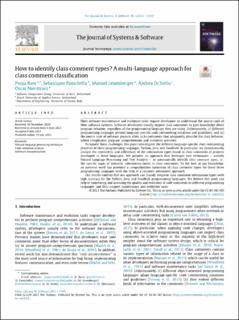Please use this identifier to cite or link to this item:
https://doi.org/10.21256/zhaw-23351Full metadata record
| DC Field | Value | Language |
|---|---|---|
| dc.contributor.author | Rani, Pooja | - |
| dc.contributor.author | Panichella, Sebastiano | - |
| dc.contributor.author | Leuenberger, Manuel | - |
| dc.contributor.author | Di Sorbo, Andrea | - |
| dc.contributor.author | Nierstrasz, Oscar | - |
| dc.date.accessioned | 2021-10-30T12:19:32Z | - |
| dc.date.available | 2021-10-30T12:19:32Z | - |
| dc.date.issued | 2021-07-19 | - |
| dc.identifier.issn | 0164-1212 | de_CH |
| dc.identifier.issn | 1873-1228 | de_CH |
| dc.identifier.uri | https://digitalcollection.zhaw.ch/handle/11475/23351 | - |
| dc.description.abstract | Most software maintenance and evolution tasks require developers to understand the source code of their software systems. Software developers usually inspect class comments to gain knowledge about program behavior, regardless of the programming language they are using. Unfortunately, (i) different programming languages present language-specific code commenting notations/guidelines; and (ii) the source code of software projects often lacks comments that adequately describe the class behavior, which complicates program comprehension and evolution activities. To handle these challenges, this paper investigates the different language-specific class commenting practices of three programming languages: Python, Java, and Smalltalk. In particular, we systematically analyze the similarities and differences of the information types found in class comments of projects developed in these languages. We propose an approach that leverages two techniques, namely Natural Language Processing and Text Analysis, to automatically identify various types of information from class comments i.e., the specific types of semantic information found in class comments. To the best of our knowledge, no previous work has provided a comprehensive taxonomy of class comment types for these three programming languages with the help of a common automated approach. Our results confirm that our approach can classify frequent class comment information types with high accuracy for Python, Java, and Smalltalk programming languages. We believe this work can help to monitor and assess the quality and evolution of code comments in different program languages, and thus support maintenance and evolution tasks. | de_CH |
| dc.language.iso | en | de_CH |
| dc.publisher | Elsevier | de_CH |
| dc.relation.ispartof | Journal of Systems and Software | de_CH |
| dc.rights | http://creativecommons.org/licenses/by-nc-nd/4.0/ | de_CH |
| dc.subject | Natural language processing technique | de_CH |
| dc.subject | Code comment analysis | de_CH |
| dc.subject | Software documentation | de_CH |
| dc.subject.ddc | 005: Computerprogrammierung, Programme und Daten | de_CH |
| dc.subject.ddc | 006: Spezielle Computerverfahren | de_CH |
| dc.title | How to identify class comment types? : a multi-language approach for class comment classification | de_CH |
| dc.type | Beitrag in wissenschaftlicher Zeitschrift | de_CH |
| dcterms.type | Text | de_CH |
| zhaw.departement | School of Engineering | de_CH |
| zhaw.organisationalunit | Institut für Informatik (InIT) | de_CH |
| dc.identifier.doi | 10.1016/j.jss.2021.111047 | de_CH |
| dc.identifier.doi | 10.21256/zhaw-23351 | - |
| zhaw.funding.eu | info:eu-repo/grantAgreement/EC/H2020/957254//DevOps for Complex Cyber-physical Systems/COSMOS | de_CH |
| zhaw.issue | 111047 | de_CH |
| zhaw.originated.zhaw | Yes | de_CH |
| zhaw.publication.status | publishedVersion | de_CH |
| zhaw.volume | 181 | de_CH |
| zhaw.publication.review | Peer review (Publikation) | de_CH |
| zhaw.funding.snf | 181973 | de_CH |
| zhaw.webfeed | Software Systems | de_CH |
| zhaw.funding.zhaw | COSMOS – DevOps for Complex Cyber-physical Systems of Systems | de_CH |
| zhaw.author.additional | No | de_CH |
| zhaw.display.portrait | Yes | de_CH |
| Appears in collections: | Publikationen School of Engineering | |
Files in This Item:
| File | Description | Size | Format | |
|---|---|---|---|---|
| 2021_Rani-etal_Identify-class-comment-types.pdf | 2.17 MB | Adobe PDF |  View/Open |
Show simple item record
Rani, P., Panichella, S., Leuenberger, M., Di Sorbo, A., & Nierstrasz, O. (2021). How to identify class comment types? : a multi-language approach for class comment classification. Journal of Systems and Software, 181(111047). https://doi.org/10.1016/j.jss.2021.111047
Rani, P. et al. (2021) ‘How to identify class comment types? : a multi-language approach for class comment classification’, Journal of Systems and Software, 181(111047). Available at: https://doi.org/10.1016/j.jss.2021.111047.
P. Rani, S. Panichella, M. Leuenberger, A. Di Sorbo, and O. Nierstrasz, “How to identify class comment types? : a multi-language approach for class comment classification,” Journal of Systems and Software, vol. 181, no. 111047, Jul. 2021, doi: 10.1016/j.jss.2021.111047.
RANI, Pooja, Sebastiano PANICHELLA, Manuel LEUENBERGER, Andrea DI SORBO und Oscar NIERSTRASZ, 2021. How to identify class comment types? : a multi-language approach for class comment classification. Journal of Systems and Software. 19 Juli 2021. Bd. 181, Nr. 111047. DOI 10.1016/j.jss.2021.111047
Rani, Pooja, Sebastiano Panichella, Manuel Leuenberger, Andrea Di Sorbo, and Oscar Nierstrasz. 2021. “How to Identify Class Comment Types? : A Multi-Language Approach for Class Comment Classification.” Journal of Systems and Software 181 (111047). https://doi.org/10.1016/j.jss.2021.111047.
Rani, Pooja, et al. “How to Identify Class Comment Types? : A Multi-Language Approach for Class Comment Classification.” Journal of Systems and Software, vol. 181, no. 111047, July 2021, https://doi.org/10.1016/j.jss.2021.111047.
Items in DSpace are protected by copyright, with all rights reserved, unless otherwise indicated.